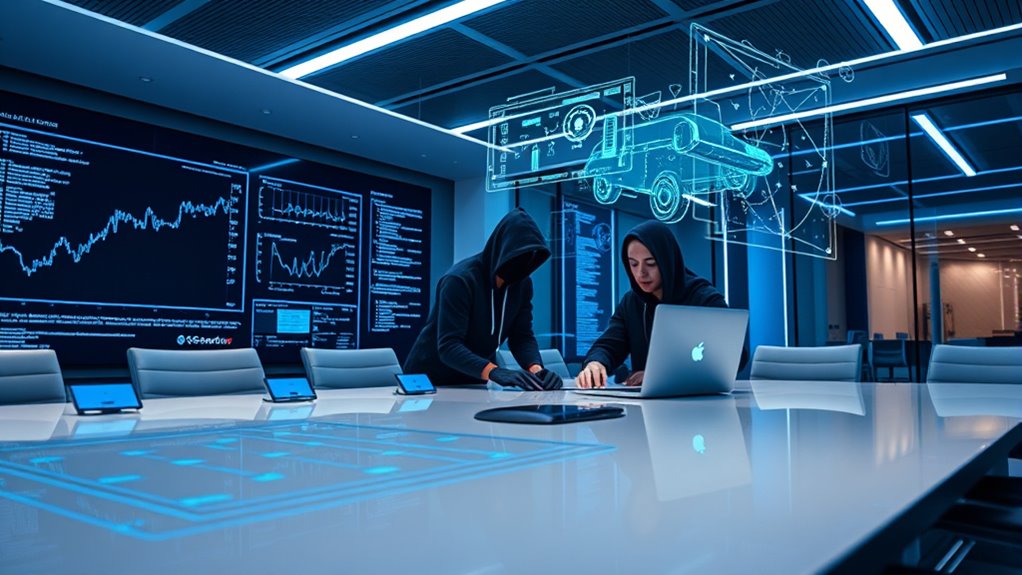The cyberattack on Jaguar Land Rover shows how hackers target automotive digital systems, exposing vulnerabilities in supply chains and customer data. It disrupted operations across manufacturing, logistics, and customer services, highlighting the need for stronger cybersecurity measures. Companies now realize the importance of proactive defenses and transparency with customers. Understanding these events can help you see how the auto industry must adapt to evolving threats—keep exploring to learn more about securing connected vehicles and industry resilience.
Key Takeaways
- The attack exposed vulnerabilities in Jaguar Land Rover’s digital infrastructure, highlighting the need for proactive cybersecurity defenses.
- Immediate containment efforts focused on isolating affected systems to prevent further operational disruption.
- The breach compromised sensitive customer data, emphasizing the importance of robust data security and transparency.
- Industry-wide implications include the urgent need for enhanced security in supply chains, vehicle networks, and software updates.
- The incident underscores the shift from reactive to proactive cybersecurity strategies to protect connected vehicles and maintain customer trust.

Have you heard about the recent cyberattack on Jaguar Land Rover? If you’re interested in cybersecurity, this incident offers a clear example of how even major automakers face serious risks from cyber threats. The attack targeted the company’s digital infrastructure, exposing vulnerabilities in their systems and causing widespread disruption. It’s a reminder that no organization is immune, and the stakes are higher than ever as cars become more connected and reliant on digital networks. You might think of a cyberattack as just a data breach, but in this case, it compromised critical operational systems, affecting manufacturing, logistics, and customer services. This disruption underscored how cybercriminals are increasingly sophisticated, capable of exploiting weaknesses in complex supply chains and internal networks.
Once the attack was detected, Jaguar Land Rover launched an immediate response, focusing on containment and recovery. They isolated affected systems to prevent further spread and worked tirelessly to restore normal operations. However, the incident highlighted gaps in their cybersecurity defenses, which had not been fully prepared for such an advanced threat. It’s a stark reminder that cybersecurity isn’t just about having the right tools; it’s about implementing proactive measures, regular updates, and continuous monitoring. You should recognize that the attack also exposed sensitive customer data, raising concerns about privacy and trust. Customers rely on automakers to protect their personal information, and breaches like this threaten that trust. It’s a wake-up call to companies everywhere to prioritize data security, especially as vehicles become more connected through IoT devices, telematics, and autonomous systems. Additionally, adopting penetration testing practices can help identify vulnerabilities before malicious actors do.
The implications extend beyond just Jaguar Land Rover. The incident signals to the entire automotive industry that cyber threats are evolving rapidly, demanding new strategies and investments in cybersecurity. Manufacturers now face increasing pressure to secure their supply chains, software updates, and vehicle networks against malicious attacks. For you, as a consumer or industry observer, this means paying closer attention to how automakers safeguard your data and vehicle systems. It also emphasizes the importance of transparency—companies must be open about breaches and their efforts to prevent future incidents. Ultimately, the Jaguar Land Rover attack is a stark illustration of the ongoing cyber risks in our increasingly digital world. It highlights the urgent need for robust cybersecurity protocols, continuous vigilance, and a shift in mindset from reactive to proactive security measures to protect both corporate assets and customer trust.
Frequently Asked Questions
What Specific Vulnerabilities Did the Attackers Exploit?
You’re asking about the specific vulnerabilities the attackers exploited. They targeted weak points like outdated software, unpatched systems, and poor access controls. By exploiting these gaps, they gained unauthorized entry into the network. You should regularly update systems, strengthen security protocols, and monitor for unusual activity to prevent similar breaches. Addressing these vulnerabilities helps protect your organization from future cyberattacks and minimizes potential damage.
How Did the Breach Affect Customer Data Privacy?
You might be concerned about your data privacy, and after the breach, your personal information could have been exposed or accessed without your consent. The attackers likely exploited vulnerabilities in the company’s security systems, risking your sensitive details like names, addresses, or payment info. This exposure may lead to identity theft or fraud, making it essential for you to monitor your accounts and stay alert for suspicious activity.
What Immediate Steps Did JLR Take Post-Attack?
Think of JLR acting like a fire brigade rushing to douse flames—you immediately isolate affected systems and shut down compromised networks. They notify relevant authorities, inform customers about the breach, and enhance cybersecurity measures. They also conduct thorough investigations to understand the breach’s scope. These swift actions aim to contain the damage, prevent further breaches, and rebuild trust, showing that they’re committed to safeguarding your data with urgency and resolve.
Could This Attack Have Been Prevented With Better Cybersecurity?
Yes, this attack could have been prevented with better cybersecurity measures. You should implement robust firewalls, keep software updated, and train your staff on security best practices. Conduct regular vulnerability assessments and invest in advanced threat detection systems. By proactively identifying and addressing weaknesses, you reduce the risk of a breach. Staying vigilant and adopting a layered security approach helps protect your organization from similar cyber threats.
What Are the Long-Term Security Measures Being Implemented?
You’ll want to witness the wide-ranging, reinforced security strategies Jaguar Land Rover adopts. They’re deploying dedicated defenses, data-driven detection, and diligent diligence to deter digital dangers. By implementing innovative intrusion-inhibitors, increasing incident intelligence, and improving infrastructure, they aim to iron out vulnerabilities. These long-term, layered measures help keep your data safe, secure, and sound, ensuring that future threats face formidable fences and fierce firewalls.
Conclusion
This cyberattack on Jaguar Land Rover shows just how vulnerable even luxury automakers are in today’s digital age. As you navigate this new era, remember that staying vigilant and updating your cybersecurity measures is essential—like securing your castle with a digital moat. If the attack had happened in the days of knights and castles, perhaps a simple drawbridge would’ve sufficed. Stay alert, because in this high-tech world, your security’s only as strong as your latest patch.









